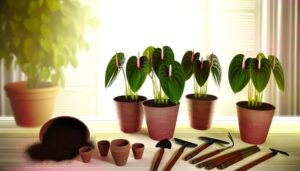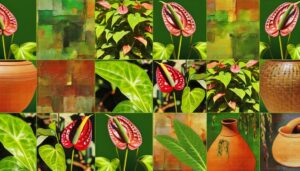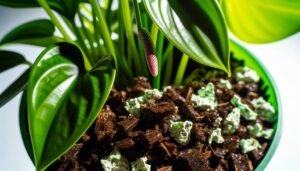7 Essential Steps for Anthurium Big Red Bird Care
To care for your Anthurium Big Red Bird, make sure it gets bright, indirect light, ideally near a north or east-facing window. Maintain temperatures between 65-80°F and humidity levels around 70-80%.
Water when the top inch of soil is dry using distilled or rainwater, and verify the pot has good drainage. Use a mix of orchid bark, perlite, and peat moss for soil.
Fertilize every 4-6 weeks with a diluted 20-20-20 solution during the growing season. Prune dead foliage to encourage new growth and regularly check for pests.
Follow these guidelines, and you’ll discover more nuanced tips.
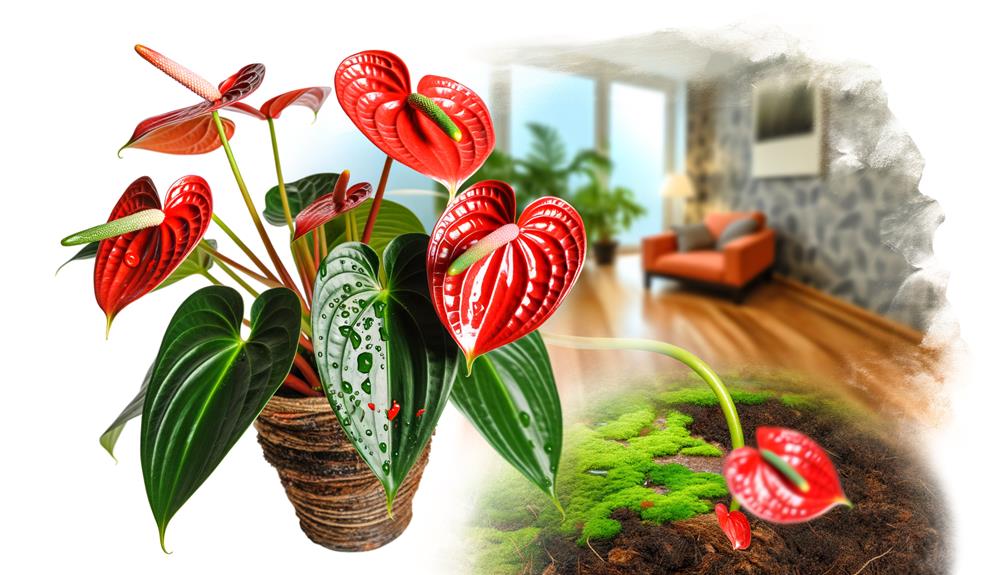
Key Takeaways
- Provide bright, indirect light by placing near a north or east-facing window.
- Maintain a temperature range of 65°F to 80°F with 70%-80% humidity.
- Water when the top inch of soil is dry, using distilled or rainwater.
- Use a loose, well-draining soil mix of orchid bark, perlite, and peat moss.
- Fertilize every 4-6 weeks with a diluted, balanced 20-20-20 fertilizer during the growing season.
Step 01: Optimal Lighting Conditions
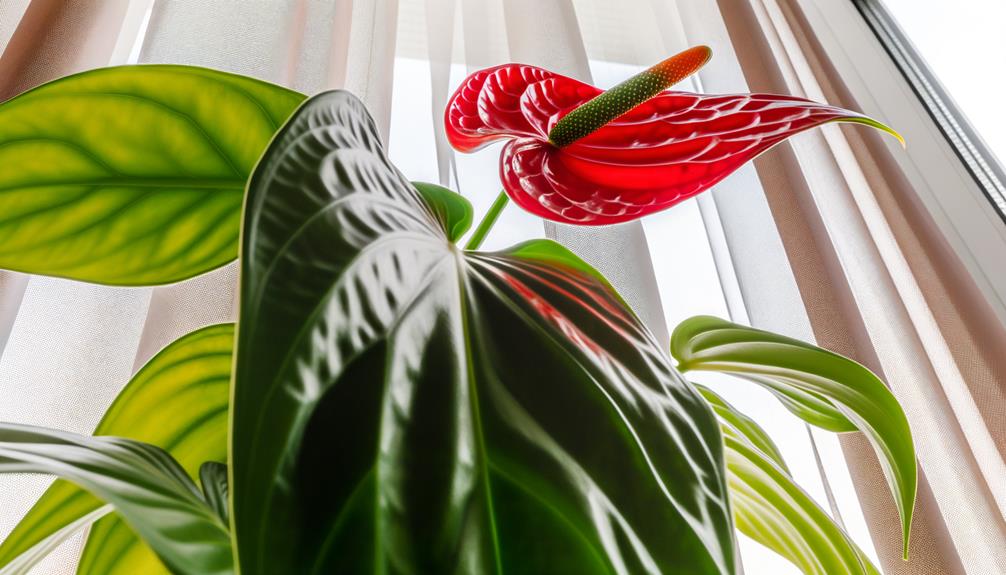
For prime growth, Anthurium Big Red Bird needs bright, indirect light to thrive. Position your plant near a north or east-facing window where it can receive ample light without direct sun exposure, which can scorch its leaves.
If natural light is insufficient, consider using fluorescent or LED grow lights. Make sure the light source is positioned 12-18 inches above the plant to mimic natural conditions.
Rotate the plant every few weeks to ensure even light distribution on all sides, promoting uniform growth. Avoid placing it in low-light areas, as this can lead to leggy growth and reduced foliage vibrancy.
Step 02: Ideal Temperature and Humidity
To keep your Anthurium Big Red Bird thriving, you’ll need to maintain a temperature range between 65°F and 80°F.
Consistently high humidity levels, ideally between 70% and 80%, are essential for best growth.
You can achieve this by using a humidifier or placing the plant on a humidity tray.
Optimal Temperature Range
Anthurium Big Red Bird thrives best in temperatures ranging from 65°F to 80°F, with humidity levels maintained between 70% and 80%. Keeping these conditions guarantees ideal growth and vibrant foliage.
You’ll want to avoid sudden temperature fluctuations, as they can stress the plant. Place your Anthurium in a spot where it receives consistent warmth, away from drafty windows or doors. If you’re in a cooler climate, consider using a heat mat or space heater to maintain the ideal range.
Additionally, monitor the ambient humidity using a hygrometer. High humidity mimics the plant’s natural tropical habitat, encouraging healthy growth and preventing issues like leaf browning. Your attention to these details will ensure your Anthurium thrives.
Maintaining Humidity Levels
Maintaining ideal humidity levels is just as crucial as temperature control, ensuring your Anthurium Big Red Bird remains healthy and vibrant. Aim for humidity levels between 60-80%. Without sufficient moisture, the leaves might develop brown tips.
You can increase humidity by misting the plant regularly, using a humidity tray, or placing a humidifier nearby. Monitoring and adjusting these conditions is vital, especially in drier climates.
Here’s a quick reference table:
| Condition | Ideal Range | Tips for Maintenance |
|---|---|---|
| Humidity Level | 60-80% | Mist daily, use humidity trays, or humidifier |
| Temperature Daytime | 70-85°F (21-29°C) | Use fans or air conditioning |
| Temperature Nighttime | 60-70°F (15-21°C) | Maintain consistent indoor climate |
Keep a hygrometer to track humidity accurately, ensuring your plant thrives.
Step 03: Proper Watering Techniques

Mastering the art of watering your Anthurium Big Red Bird just right is essential for its thriving. Water your plant when the top inch of soil feels dry to the touch.
Use distilled or rainwater to prevent mineral buildup, which can damage the roots. Water thoroughly until it drains out of the bottom for consistent moisture distribution.
However, avoid leaving the plant in standing water to prevent root rot. During winter, reduce the frequency of watering as the plant’s growth slows down. Always monitor the plant’s surroundings; higher humidity may require less frequent watering.
Step 04: Soil and Potting Mix
Choosing the right soil and potting mix is crucial for providing ideal aeration, drainage, and nutrients for your Anthurium Big Red Bird. Aim for a mix that’s loose, well-draining, and rich in organic matter.
Combine equal parts of orchid bark, perlite, and peat moss to create an excellent blend. The orchid bark promotes good aeration, perlite improves drainage, and peat moss retains moisture without becoming waterlogged.
Avoid heavy, compact soils that can suffocate roots and lead to root rot. Always use a pot with drainage holes to prevent water accumulation. Repot every two years to refresh the soil and check for root health.
This careful attention to soil composition will help your Anthurium thrive and serve as a stunning focal point.
Step 05: Fertilizing Your Anthurium
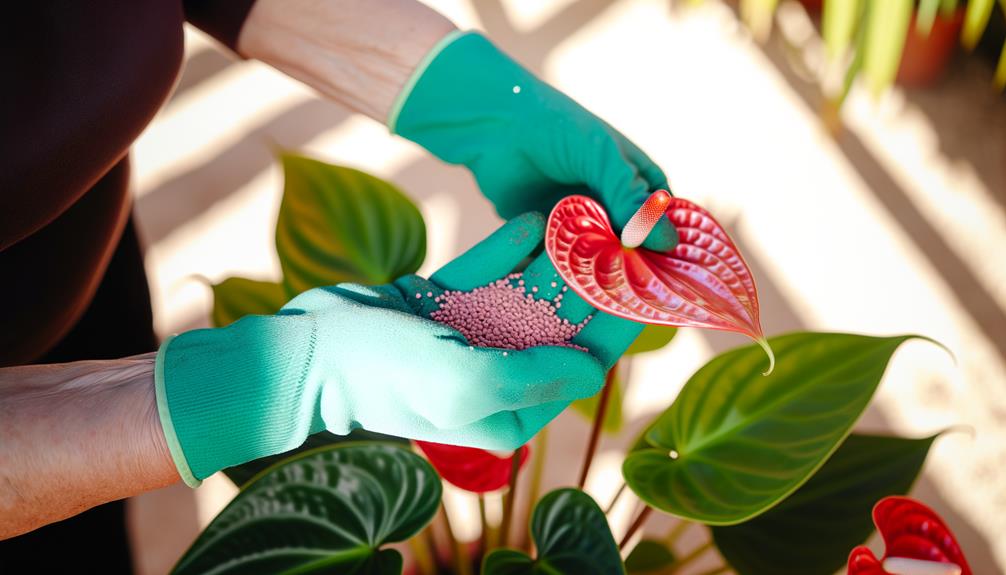
Regularly fertilizing your Anthurium Big Red Bird with a balanced, water-soluble fertilizer every 4-6 weeks during the growing season will guarantee excellent health and vibrant foliage. Choose a fertilizer with equal parts nitrogen, phosphorus, and potassium, such as a 20-20-20 mix.
Dilute the fertilizer to half the recommended strength to avoid root burn. Apply it evenly to moist soil, ensuring the nutrients reach the root zone effectively. Avoid fertilizing during the dormant winter months to prevent nutrient buildup.
Keeping a consistent feeding schedule and monitoring your plant’s response will help you adjust as needed, ensuring your Anthurium thrives. Always prioritize the plant’s well-being, as your attentive care directly influences its growth and beauty.
Step 06: Pruning and Maintenance
To maintain your Anthurium Big Red Bird healthy, you should regularly remove dead leaves using sterilized pruning shears.
This practice not only enhances the plant’s appearance but also promotes new growth by redirecting nutrients.
Make sure you make clean cuts close to the base to prevent disease.
Removing Dead Leaves
When pruning your Anthurium Big Red Bird, focus on removing dead leaves to promote healthy growth and prevent potential disease.
Begin by examining the plant thoroughly. Use sanitized pruning shears to trim off any yellowed, brown, or wilted leaves at the base of the stem.
This prevents the spread of pathogens and ensures that the plant’s energy is directed towards healthy foliage.
| Step | Description |
|---|---|
| Examine | Check for yellowed, brown, or wilted leaves |
| Sanitize Tools | Use alcohol or bleach to clean pruning shears |
| Trim | Remove dead leaves at the base of the stem |
| Discard | Dispose of removed leaves to prevent contamination |
Maintaining a clean environment around your Anthurium Big Red Bird is essential, as it minimizes the risk of disease and supports vibrant growth.
Encouraging New Growth
Pruning your Anthurium Big Red Bird strategically encourages new growth by redirecting the plant’s energy towards developing robust and healthy leaves.
Start by identifying any leggy or weak stems, then trim them back to just above a leaf node using sterilized pruning shears.
This method not only promotes bushier growth but also prevents disease. Remove any yellow or damaged leaves promptly, as they can drain nutrients from healthier parts of the plant.
Regularly check for any signs of pests or fungal infections and treat them immediately to maintain peak health.
By maintaining a consistent pruning schedule, you’re ensuring that your Anthurium Big Red Bird remains vibrant and continues to thrive, serving as a beautiful focal point in any space.
Step 07: Pest and Disease Management

Proper pest and disease management for your Anthurium Big Red Bird involves regularly inspecting the plant for common issues like spider mites, aphids, and root rot. Use a magnifying glass to identify tiny pests on the undersides of leaves.
If you spot spider mites or aphids, treat the plant with insecticidal soap or neem oil. For root rot, make sure the soil drains well and avoid overwatering. Trim any affected roots with sterilized scissors, and repot the plant in fresh, well-aerated soil.
Conclusion
Caring for your Anthurium Big Red Bird is like tending to a cherished vintage car. Just as a classic car thrives with the right fuel, temperature, and meticulous maintenance, your Anthurium flourishes with the best light, consistent watering, and proper nutrients.
By following these seven steps, you’re ensuring your plant remains vibrant and healthy, ready to impress. Remember, every detail counts—overlooking even a minor aspect can derail your plant’s stunning display, much like neglecting a single component can stall a vintage car.

